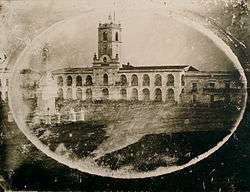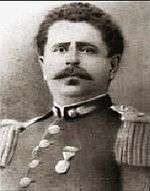Juan de Canaveris
| Juan de Canaveris | |
|---|---|
| Official in the Buenos Aires Cabildo | |
|
In office 1770s – 1809 | |
| Personal details | |
| Born |
Giovanni Antonio Domenico Jugluns Canaveri 1748 Piedmont, Kingdom of Sardinia |
| Died |
August 22, 1822 Buenos Aires, United Provinces of the River Plate |
| Resting place | Church of La Merced |
| Nationality | Italian |
| Political party | Patriot |
| Spouse(s) | Catalina Bernarda de Esparza |
| Occupation |
Government Farmer |
| Profession | Legal |
| Religion | Catholicism |
Juan de Canaveris (Piedmontese: Gioann Canaverij) (1748–1822) was an Italian lawyer. He served as accounting officer in the Tribunal de Cuentas de Buenos Aires, during the viceroyalty of Río de la Plata.[1] Canaveris had achieved a high social status in the Viceroyalty of the Río de la Plata (member of the Church),[2] where supported the revolutionary movements of May, being the only Italian who attended in the Open Cabildo, on May 22, 1810.[3]
Biography
Giovanni Canaveri was born in 1748 at Saluzzo, Province of Cuneo (Italy),[4] son of Gabriel Canaveri and Margarita Jugluns, descendant of French. He probably lived and studied in Genoa, in the census of 1807 and 1809 is indicated as of Genoese origin.[5]
Juan Canaveris arrived at Buenos Aires about 1770, in times of the Bourbon Reforms in the Spanish South America. He married at the Cathedral of Buenos Aires on May 4, 1772, with Catalina Bernarda de Esparza, a powerful aristocratic lady,[6] daughter of Juan Miguel de Esparza and María Eugenia Sánchez.[7]
Canaveris and his wife lived in the neighborhood of San Nicolás, had twelve children, six boys and six girls: María Ramona (1773), María Antonia (1774), sister of the Third Order of Saint Dominic,[8] wife of Fernando Linera, merchant, employee in the Consulate.[9]
María Dominga, married to Mariano Lazcano, member of the Court of Auditors, Juan Miguel Canaveris (1778-1802, godson of Mariano Olier), Juan Joseph Canaveris (1780-1837, lawyer in the city), María Eugenia (1782-1812), buried in San Francisco), wife of Juan Bayá Mas Rosel (born in Girona), mother of Juan Manuel Bayá and Antonina Bayá, wife of Felipe Achinelli.
Mariano Canaveris (school teacher),[10] whose son Juan Segundo Canaveris Ravelo (b.1816), was godson of Juan Bautista Vitón- Manuel Canaveris, Lieutenant in 4th Regiment,[11] Joaquín Canaveris (1789-1840s), Juana Josefa, served in the government of Juan Manuel de Rosas,[12] mother of Sinforoso Amoedo and Felipe Amoedo, José Mariano de la Cruz (b.1791). And María de la Encarnación Canaveris (died in Carmen de Areco), wife of Alejo Menchaca, native of Biscay.[13] The Canaveri's house was located in the vicinity of Fonda de los Tres Reyes, the main inn in the city in early 1800.[14]
Juan Canaveris was grandfather of Sinforoso Amoedo[15] and Ángel Canaveris, two prestigious doctors in medicine and psychiatry.[16]
Career


Canaveri change your name on Spanish official documents as Canaverys (frenchified), and in books records is cited as Canaveris. In 1777, Juan Canaveris had been designated as "portero" of the Court of Accounts of Buenos Aires.[17] He was employee of the Tribunal de Cuentas until 1786, he returned to work in the court on an interim basis in the years of 1800.[18] The notary of the Court of Auditors in those years was Tirso Martínez.[19]
In 1795, Canaveris was appointed as representative of the Protector Guardian of Natural resources and Indians in the village of San Pablo, Capinota Province, Bolivia.[20] In 1796 Canaveris was legal representative of Francisco Antonio Maciel to manage the approval, the Diocesan of Buenos Aires, for the construction of a public hospital in Montevideo.[21] In 1798, Juan de Canaveris served as attorney in the Council of Santiago del Estero, on behalf of the elected aldermen of the City Council. Canaveris had presented a writ of grievances in defense of aldermen to the Viceroy Antonio de Olaguer y Feliú, to avoid contesting the elections, held in that province in July 20, 1796.[22]
During the British invasions of the Río de la Plata, Canaveris had participated in secret meetings organized by residents of the city.[23] And collaborated with the money donations organized by the Cabildo of Buenos Aires, chaired by Martín de Alzaga.[24] His sons, José,[25] Mariano, Manuel, and Joaquín participated in the defense of Buenos Aires in the regiments — Quinteros and Labradores, Húsares of Pueyrredón, Cántabros Montañeses and Tercio de Vizcaínos.[26] The Friar Martin Esparza, a relative of Canaveris's wife, was killed by British troops during the second invasion in the interior of Convent of Santo Domingo.[27]
In the May Revolution of 1810, Canaveris was one of neighbors attending the open Cabildo. He reproduced the vote of Feliciano Chiclana in favor of dismissing the Viceroy Baltasar Hidalgo de Cisneros.[28]
In 1813 Juan Canaveris was the owner of a farm in the town of San Isidro, their lands were in the vicinity of the hacienda of Miguel de Azcuénaga, personal friend of Canaveris and his family.[29] He also owned lands in the town of Quilmes, being one of the few residents of that town, who had participated in the open cabildo of 1810.[30]
Descendants

His descendants include Feliciano Canaveris, Tomás Canavery (priest), Ángel Canavery, military attaché in Italy, Saturnino Canaveri (Lieutenant colonel),[31] and Isabelino Canaveris (Commandant).[32] Other descendants include Juan Manuel Canaveris (attorney) trading partner of British and Genoese merchants in Buenos Aires.[33] Héctor Canavery, congressman in the Province of Buenos Aires.[34] Manuel Canaveri (b.1854, Montevideo, Procurador),[35] husband of Luisa de Alvarado Périchon, relative in law of Ernesto Rouquaud.
Camilo Canaveri (revolutionary of the Park),[36] attorney that on legal representation of a citizen, won a lawsuit against a British insurance company in 1912.[37]
Sinforoso Canaveri notary of La Plata, who in October 27, 1888 provides legal verification of Nicolás Levalle, where bequeaths property in Olavarria in favor of Florencio Monteagudo (military and expeditionary of desert).[38]
Joaquín Canavery (godson of Miguel Cuyar) Intendant of Carmen de Areco, father in law of Baldomero Lamela. Samuel Canaveris, accountant in the Casa de Moneda de la República Argentina,[39] whose son, Carlos M. Canaveris Fornaguera was student at the Naval Academy (Escuela de Maquinistas Navales), educational establishment directed by the Captain Carlos B. Massot, Consul of the Argentine Republic at Newport, Wales,[40] Carlos Canaveris carried out a course of improvement in the shipyard of the company Vickers of Barrow-in-Furness (England).[41]
His most important descendant was the General Enrique Mosconi Canavery (1877-1940), graduated from Faculty of Exact and Natural Sciences, as civil engineer, was pioneer in organizing the exploration and exploitation of oil in Argentina.[42]
His great-granddaughter Isabel Celia Canaveri (poet), was the author of the poem "El cardo azul" recorded by Carlos Gardel and José Razzano.[43]
Juan Canaveris also was the ancestor of Zoilo Canavery amateur football player of Racing Club de Avellaneda and Club Atlético Independiente. And of Pedro Canaveri president of the Argentine Football Association in 1946.
In the mid and late 19th century they arrived at the port of Buenos Aires, at least four or five families with the surname Canaveri and Canaveris,[44] (established in Argentina and Uruguay), without any relationship with the family of Juan Canaveris. Most of the descendants of the Canaveris Esparza family used the surname Canavery, the Anglicized or Frenchified version of the original name of Canaveri.[45]
References
- ↑ Revista de historia del derecho, Número 21, Instituto de Investigaciones de Historia del Derecho
- ↑ Fundadores de Capellanias, Patrimonios y Obras Pias en Buenos Aires (1600-1820) (PDF), Ernesto Saguier
- ↑ Nuevo diccionario biografico argentino: (1750-1930), Vicente Osvaldo Cutolo
- ↑ Cuarto Congreso Internacional de Historia de América:
- ↑ Documentos para la historia Argentina, Volumen 12, Argentina
- ↑ La dinámica mercantil de las mujeres rioplatenses frente al resquebrajamiento del Antiguo Régimen (1806-1810) (PDF), Aguirrezabala, Marcela Silvia - Universidad Nacional del Sur
- ↑ Catálogo de documentos del Archivo de Indias en Sevilla:, República Argentina
- ↑ Hermanos Terciarios de Santo Domingo en Buenos Aires (PDF), Ernesto Saguier
- ↑ Consulado de Buenos Aires, Volumen 2, Río de la Plata (Viceroyalty) Consulado, Héctor C. Quesada
- ↑ Archivo del doctor Juan María Gutiérrez, Juan María Gutiérrez, Biblioteca del Congreso de la Nación (Argentina)
- ↑ Il lavoro degli italiani nella Republica Argentina, dal 1516 al 1910:, Emilio Zuccarini
- ↑ Escritos politicos y literarios de D. Andres Lamas durante la guerra contra la tirania de D. Juan Manuel Rosás:, Andrés Lamas
- ↑ Genealogía, Issues 13-15, Instituto Argentino de Ciencias Genealógicas
- ↑ Territorio y población, Volumen 12, Universidad de Buenos Aires. Instituto de Investigaciones Históricas
- ↑ Cuando murió Buenos Aires, 1871, La Bastilla, 1974
- ↑ Pedro Visca: fundador de la clínica médica en el Uruguay, s.n., 1983 - Physicians
- ↑ Astigiani nella Pampa: l'emigrazione dal Piemonte, dal Monferrato e dalla provincia di Asti in Argentina, Giancarlo Libert
- ↑ Vida forense y administrativa en el virreinato del Río de la Plata, Alberto David Leiva
- ↑ Historia: revista bi-mensual, Volumen 1, Cabaut y Cía
- ↑ Tomas de razón de despachos militares, cédulas de premio, retiros, empleos civiles y eclesiásticos, donativos, etc., 1740 a 1821, Archivo General de la Nación (Argentina)
- ↑ Memoria historica del Hospital de Caridad de Montevideo: desde su fundacion, Isidoro De-María
- ↑ Actas capitulares de Santiago del Estero: 1792 a 1805 (v5), Ricardo Levene
- ↑ Ensayo histórico sobre la revolución de mayo y Mariano Moreno:, Ricardo Levene
- ↑ Documentos relativos a la actuación de Martín de Alzaga en la reconquista y en la defensa de Buenos Aires (1806-1807), Enrique Williams Alzaga
- ↑ Invasiones inglesas al Río de la Plata 1806-1807, Marcos de Estrada
- ↑ Todo es historia, Issues 450-461 (PDF), Todo es Historia, 2005
- ↑ Las Invasiones Inglesas, Isaac Pearson
- ↑ colección de obras y documentos para la historia argentina, Pedro de Angelis
- ↑ Documentos eclesiásticos y civiles de San Isidro: siglos XVIII y XIX, Aldo Abel Beliera, Instituto Argentino de Ciencias Genealógicas
- ↑ Historia de Quilmes desde sus orígenes hasta 1941, José Alcides Craviotto
- ↑ Argentina-Chile, una frontera caliente, Editorial de Belgrano, 1981 - Argentina
- ↑ Por la patria: la Revolución de 1897 y sus antecedentes, Volume 1. Luis Alberto de Herrera.
- ↑ Latin American Bureaucracy and the State Building Process (1780-1860), Juan Carlos Garavaglia,Juan Pro Ruiz
- ↑ Archivo y colección'Los López', Archivo General de la Nación, Documentos Escritos, Jan 1, 1999
- ↑ Jurisprudencia criminal y comercial:, Buenos Aires (Argentina). Cámara de Apelación de la Capital
- ↑ Crotto: historia de una ingratitud, Ernesto Quiroga Micheo, Ernesto Raúl Quiroga Vergara
- ↑ Jurisprudencia de los tribunales nacionales: Publicación dirigida por la Inspección general de justicia, Argentina. Courts
- ↑ Archivo histórico Olavarría, Volume 1, Part 1, Municipalidad de Olavarría
- ↑ Papel moneda nacional, Caras y Caretas
- ↑ Foreign Office (PDF), The London Gazette
- ↑ La Escuela de Maquinistas en Inglaterra, Caras y Caretas
- ↑ Revista, Volume 40, Issues 474-479, Círculo Militar (Buenos Aires, Argentina)
- ↑ Carlos Gardel y los autores de sus canciones, Orlando del Greco
- ↑ Cemla (buscador), Centro de Estudios Migratorios Latinoamericanos
- ↑ Gazzetta del popolo, Issues 155-309, daily Piedmontese
External links
- familysearch.org
- familysearch.org
- familysearch.org
- Documentos para la Historia Argentina (padrón de la ciudad 1778) - archive.org
- Documentos para la Historia Argentina (padrón de extranjeros) - archive.org
- Trapalanda biblioteca digital
- er-saguier.org